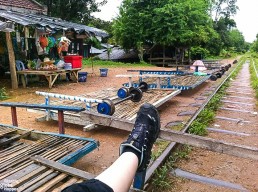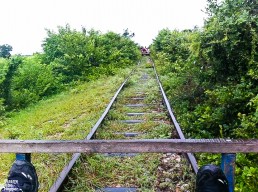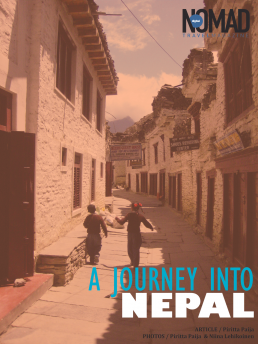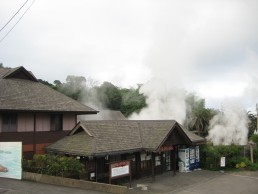A short stretch of mostly overgrown railway, a remnant from the colonial past, still exists on the outskirts of Battambang, Cambodia. Climb on a makeshift trolley, hang on, and go for a ride on the famous bamboo train.
Even today Cambodia still hasn’t got a properly working railway system. The French colonial settlers built a network of 612 kilometers, but the Khmer Rouge regime shut it down. Nowadays most of it lay abandoned and decayed. It’s rumored that there are government plans to revive the whole railway network, but it as been in the planning stage for years now. Time will tell whether it ever be accomplished. As of today, the project has only completed a railway from Phnom Penh to Sihanoukville.
Locals used the bamboo trains (or nori in Khmer) to transport goods and people to other villages during the civil war when they were a cheap and even an enough fast mode of transportation. Initially, the nori was propelled by hand, but nowadays they have either a tractor or a motorcycle engine attached.
Ride On The Bamboo Train
If you wonder what to do in Battambang, riding the bamboo train is one of the top picks. The bamboo train lays on the outskirts of Battambang, and you have to get a tuk-tuk or a scooter to get there. Your driver will wait for you at the starting – and ending – point. Remember that today the bamboo train runs mostly for the fun of the tourists. It just runs the relatively short way to a nearby village and back.
The bamboo train is actually owned by one man, and all the drivers are working for him. You pay your fee of 8 USD/person and off you’ll go. You’re seated on bamboo slats and a carpet laid on a metal frame, and your driver sits at the back of the engine. Once we had embarked on our journey, the trolley quickly accelerated into a considerable speed, and the green bushes and the lush Cambodian countryside started to flash before our eyes.
The bamboo train can achieve speeds up to 40-50 km/h, so hang on tight! We were happy to have our own trolley, but it soon dawned that it wasn’t always an advantage. Since the track is only one-way, you’ll probably encounter trolleys coming to the opposite direction. When that happens, the one with the fewer passengers on board gives way to the other. We had to give way more than once. When this occurs, you have to get off, and the drivers will disassemble the trolley by hand, one piece at a time, and assemble it again behind the other trolley. Once it’s done, you hop back on board and continue your journey.
The tracks have certainly seen better days and seem like they’ve decayed long ago. Vast holes and planks are missing under the tracks, especially on the bridges, and you can see straight down. If you get easily scared, don’t look. It had started to rain already when we left, but that didn’t bother us so much in the thrill of the speed. The rain did make the already poor conditioned tracks more slippery, though.

The Village at the End of the Line
When the nori reaches the little village at the turning point, it’ll have a mandatory stop for a time that can vary from 15 minutes to even half an hour. Our driver went for lunch to a nearby shop, and we wandered around the stop for a few moments. There were many, little shops selling warm sodas, beer, and scarfs at the stopping station.
Fairly quickly we were approached by a local suggesting that we should buy something. We are hard to persuade but agreed to have a look. After awhile we ended up buying two cans of beer while waiting for our ride back and for our driver to finish his lunch. Kids and few adults swarmed around us from time to time, trying to sell different things, which made us feel a bit uncomfortable. Luckily a bunch of village boys were goofing around in the mud and entertained us by posing for our camera.
Finally, our driver arrived, assembled our nori and our journey back began. When we were leaving, a local, older woman said to us – many times – that we should tip our driver. We got an impression that all the fees go to the owner of the bamboo train, and the drivers are paid only little amounts, so the tips were a big part of their income.
It was no surprise, but all this ”over pushing” made us feel oppressed and we weren’t so excited about the tipping demand. It should be voluntary, after all. However, when we arrived back to our starting point, we decided to give the driver a few extra dollars.
All in all, the experience was fun, and this was one of the reasons why we had come to Battambang in the first place. But riding the bamboo train would have been a much more pleasant experience without the locals being so plying. It always makes a general feeling quite intimidating.
Nevertheless, if you still want to have a glimpse of how traveling was like in the old days, stop by in Battambang. If the Cambodian government’s plans for rebuilding the railways come true, the bamboo train of Battambang will be gone. But for now, there’s still a chance to go.
Have you done this? Tell us, we’d love to know how was your experience on the Bamboo train of Battambang!
*NOTE: Sorry for the bad quality of the pics, they’ve been taken with on old iPhone 4, that being the only camera which we had with us there.

You May Also Like to Read:
The Strange Charm of the Bokor Hill Station in Cambodia
Bokor Hill Station in Cambodia has an intriguing history. It’s been a casino and a stronghold of Khmer Rouge. And locals say it’s haunted.
Valencia’s Old Town Merges Famous Sights With Street Art
Narrow alleys of El Carmen host a weird mix: subcultures and street art, orange gardens, old mansions, and the most iconic sights of the city.
In the onsens of Beppu in Japan
Beppu has the best natural onsens of Japan, a sex museum with a really vast collection, and a wild nightlife. Take a peek into this historical, little town.





